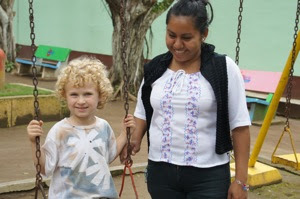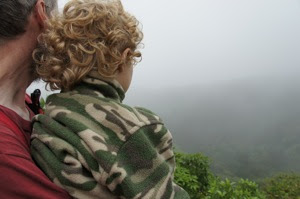


Tuesday,  July 26
July 26
Talking with the teachers here makes we want to go into health services of one kind or another. Partly, it’s a matter of seeing how many people have been deeply affected by physical ailments—their own or others'. Johanna, my teacher this week, lost her 13-year-old son last year from a sudden fever: he died within two or three days of being very well. So now she has a ten-week-old baby, which she conceived quite deliberately not as a replacement for her lost son, but as a reason to keep going. She lost her mother when her youngest siblings were 8 and 9, and five of the seven siblings still live together. She’s the eldest, so she’s their second mother. In addition to her baby boy, her household includes a sister (31) with three children (16, 10, 6 months); a brother (30); another brother (24), severely injured in the running of the bulls—he broke his femur and a bunch of ribs, completely lost his jawbone and had to have 18 reconstructive surgeries—and still suffering the results; and a sister (23). They share a small house: three of the five siblings have work. The injured brother works in one of the sweatshops (Zona Franca) run by Koreans and Taiwanese in Nicaragua. He works twelve-hour days, four days on, four days off; for each four-day period or 48 hours, he makes $35. I think that works out to 73 cents an hour. Johanna worked in the sweatshops for eleven years: “It was hard work, but I was able to buy my house. It’s a small house, but it’s what I needed.” She works both as a teacher here, and as cook and a cake-maker to keep making ends meet.
Elisa lost her mother at age 3, from (in Nicaraguan terms at least) leukemia (“cancer of the blood”) caused by “aggravated anemia.” Evidently, in Nicaragua, people talk about three levels of anemia: the first is mild and easily treated; the second is more severe and complicated by malnutrition; the third leads to “blood cancer” and is considered largely irreversible. (???) I really want to know if there’s a way to translate this into something that would make logical sense to me. Again, families stick together: Elisa’s sister paid the fees that allowed Elisa to get her diploma from high school, and she desperately wants Elisa to move to Costa Rica to live with her.
(Elisa doesn’t want to because she doesn’t like the prejudice of Costa Ricans [Ticos] against Nicaraguans [Nicas]. Within a few months of moving, most Nicas change their accents and their way of speaking to blend in, but on a visit of five months, she refused to change. The change is big. Most Nicaraguans use the form “vos” at work, at home, and in the street: they only use “tu” with us foreigners because they know we like to use it. But Ticos only use usted, which must seem terribly foreign to a Nica.)
Back to health care: Johanna told me today that her sister gave her baby Tylenol for a fever at two months of age, and the baby had a convulsion and turned purple, and when they rushed the baby to the hospital, the doctors told them a) not to self-medicate and b) that for babies, Tylenol had to be mixed with milk or it would cause convulsions. Pardon my skepticism.
Health care is free here, as long as you have the time to wait until you can be seen. But at least it’s something. And the children are all vaccinated: even during the war, the Sandinistas were happy to declare a week’s peace to enable all children in a particular area to be inoculated against polio. Polio was eradicated in Nicaragua in the middle of a civil war. Betsy the nurse went on some vaccination rounds with the health care center where she was volunteering and evidently all the parents could produce their children’s vaccination records (puts me to shame!). Aubrey said that Nicaragua has an unbelievable 98% vaccination rate—and the 2% could just be parents who can’t produce the written record.
During our “grammar class” today, Lana (a lactation specialist) and I went to visit Jami’s 6-day-old grand-daughter, to see if Lana could help the 18-year-old mother breast-feed more effectively: the baby kept pulling off and wailing. Lana works in a hospital where 48% of the births are to mothers who only speak Spanish, and so she has most of the terminology down in Spanish. It was really interesting to watch her work—and to see (with people skills eyes) how much people say in their silences: she’s fine during the day (means… but not at night); the mom keeps nodding about the idea of freeing one hand from holding the baby to position the breast but doesn’t do it, because she doesn’t feel the baby is secure.
Life is so vulnerable here, but social ties seem correspondingly stronger. Johanna’s family and neighbors clubbed together to pay for her brother’s artificial jaw: an unbelievable $750. Remember that a teacher makes about $250 a year…. Together, they find the strength to go on.


























































